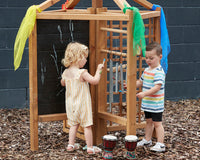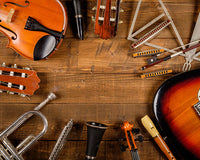 The first thing to do is identify the tools you are going to need.
The first thing to do is identify the tools you are going to need. Some of these tools include a ruler, allen keys,
a chromatic tuner and screwdrivers (...on standby).
Make sure to buy high-quality tools that fit well within your budget. The main advantage of good quality tools is that they last longer.
 Check the neck for any signs of curving excessively.
Check the neck for any signs of curving excessively. It said that wood produces the most wonderful sound. Wood is however sensitive to changes in temperature and humidity as this causes it to expand and contract regularly. Even though these changes take place they are barely noticeable, visibly.
They can, however, affect how your
guitar sounds. The curve along the length of the neck, also known as the relief, should be inspected for any needed adjustments. A straight neck can be identified by using the D string as a straight edge.
If the neck is straight, there will be a small gap between the neck and the frets in the middle of the neck. This gap ought to be big enough for a card to fit through.
 If your neck is still not completely straight, proceed to adjust the truss rod.
If your neck is still not completely straight, proceed to adjust the truss rod.
This refers to a long metallic rod which is fit into the neck of a guitar. The truss rod is adjusted by using allen keys. It affects the curvature of the neck through either loosening or tightening it. If the neck is back bowed then it requires some much-needed tightening.
If the neck is front bowed, then it needs the opposite, which is loosening it a little. When the neck is back bowed, turn the truss clockwise in careful small turns. When the neck is front bowed, (relief) turn the truss anticlockwise in small turns. Making small turns ensures that you are handling your
guitar gently.
 Replace your old guitar strings with some new ones.
Replace your old guitar strings with some new ones.
After doing this you are sure to hear the difference in the sounds you produce. You will be able to create stronger and finer tunes.
As you buy your new strings make sure to buy the ones meant for your
guitar. Do not buy yourself some
electric guitar strings for your
acoustic guitar and be shocked once you get home. Newer and stronger strings will produce strong tones.
 The tool to use here is a chromatic tuner.
The tool to use here is a chromatic tuner.
Take a look at the gap between the strings and the twelfth fret. A fret is a raised element on the neck of a stringed instrument.On guitars, frets are the silver strips of metal that run up and down the whole length of most fingerboards.
A fingerboard, (also known as a fretboard,) is a strip of a long and thin material usually made out of wood, which is laminated onto the front part of the neck of an instrument.After checking the gap, you can raise or lower it by adjusting the bolts at the bridge.
The bridge is just the device which supports the strings. Turn the bolts anticlockwise to raise the bridge and turn the bolts clockwise to lower the bridge. Measure out the gap between the string and the fret with a ruler.Next, check every fret for buzz. This is the buzzing sound produced as a result of when the vibrating part of one or more strings strikes the frets higher than the open note.
This sound is known to be annoying to the extent of dampening a note. If by any chance you find a buzz on a fret you can minimize it by raising the bridge.
 At this step we are still going to use the chromatic turner but this time to tune every string.
At this step we are still going to use the chromatic turner but this time to tune every string. Setting the intonation requires you to move the saddles either forward or backward until every note plays in tune.
Sharp notes are adjusted by moving the saddle towards the tailpiece and flat notes by doing the opposite.
All you have to do is pluck one of your
guitar strings unfretted then press the twelfth fret and pluck it once more. If the note you've played shows in tune, consider your intonation well set.

The Importance of a Guitar Setup
A successful guitar setup involves adjusting a guitar so that it plays and sounds at its best after being correctly intonated. The following show what can be achieved by a setup guitar:
- No buzzing at any fret
- Easier playing
- All rough edges are eliminated
- Better production of sound
The final step after this entire process is to play your guitar. You will hear the difference in the sounds produced as you play your guitar. The more times you setup your guitar, the more sensitive you will become to your guitars tones. Plus, you will always be able to do the whole setup by yourself. This will ensure that you know how to keep your guitar in tune.
This all sounding a bit technical for you? Alternatively, Normans are able to offer a basic setup for a small fee. Drop them a call or email to find out more.
You can read more from Joseph
here.
 The first thing to do is identify the tools you are going to need. Some of these tools include a ruler, allen keys, a chromatic tuner and screwdrivers (...on standby). Make sure to buy high-quality tools that fit well within your budget. The main advantage of good quality tools is that they last longer.
The first thing to do is identify the tools you are going to need. Some of these tools include a ruler, allen keys, a chromatic tuner and screwdrivers (...on standby). Make sure to buy high-quality tools that fit well within your budget. The main advantage of good quality tools is that they last longer.
 Check the neck for any signs of curving excessively. It said that wood produces the most wonderful sound. Wood is however sensitive to changes in temperature and humidity as this causes it to expand and contract regularly. Even though these changes take place they are barely noticeable, visibly.
They can, however, affect how your guitar sounds. The curve along the length of the neck, also known as the relief, should be inspected for any needed adjustments. A straight neck can be identified by using the D string as a straight edge.
If the neck is straight, there will be a small gap between the neck and the frets in the middle of the neck. This gap ought to be big enough for a card to fit through.
Check the neck for any signs of curving excessively. It said that wood produces the most wonderful sound. Wood is however sensitive to changes in temperature and humidity as this causes it to expand and contract regularly. Even though these changes take place they are barely noticeable, visibly.
They can, however, affect how your guitar sounds. The curve along the length of the neck, also known as the relief, should be inspected for any needed adjustments. A straight neck can be identified by using the D string as a straight edge.
If the neck is straight, there will be a small gap between the neck and the frets in the middle of the neck. This gap ought to be big enough for a card to fit through.
 If your neck is still not completely straight, proceed to adjust the truss rod.
This refers to a long metallic rod which is fit into the neck of a guitar. The truss rod is adjusted by using allen keys. It affects the curvature of the neck through either loosening or tightening it. If the neck is back bowed then it requires some much-needed tightening.
If the neck is front bowed, then it needs the opposite, which is loosening it a little. When the neck is back bowed, turn the truss clockwise in careful small turns. When the neck is front bowed, (relief) turn the truss anticlockwise in small turns. Making small turns ensures that you are handling your guitar gently.
If your neck is still not completely straight, proceed to adjust the truss rod.
This refers to a long metallic rod which is fit into the neck of a guitar. The truss rod is adjusted by using allen keys. It affects the curvature of the neck through either loosening or tightening it. If the neck is back bowed then it requires some much-needed tightening.
If the neck is front bowed, then it needs the opposite, which is loosening it a little. When the neck is back bowed, turn the truss clockwise in careful small turns. When the neck is front bowed, (relief) turn the truss anticlockwise in small turns. Making small turns ensures that you are handling your guitar gently.
 Replace your old guitar strings with some new ones.
After doing this you are sure to hear the difference in the sounds you produce. You will be able to create stronger and finer tunes.
As you buy your new strings make sure to buy the ones meant for your guitar. Do not buy yourself some electric guitar strings for your acoustic guitar and be shocked once you get home. Newer and stronger strings will produce strong tones.
Replace your old guitar strings with some new ones.
After doing this you are sure to hear the difference in the sounds you produce. You will be able to create stronger and finer tunes.
As you buy your new strings make sure to buy the ones meant for your guitar. Do not buy yourself some electric guitar strings for your acoustic guitar and be shocked once you get home. Newer and stronger strings will produce strong tones.
 The tool to use here is a chromatic tuner.
Take a look at the gap between the strings and the twelfth fret. A fret is a raised element on the neck of a stringed instrument.On guitars, frets are the silver strips of metal that run up and down the whole length of most fingerboards.
A fingerboard, (also known as a fretboard,) is a strip of a long and thin material usually made out of wood, which is laminated onto the front part of the neck of an instrument.After checking the gap, you can raise or lower it by adjusting the bolts at the bridge.
The bridge is just the device which supports the strings. Turn the bolts anticlockwise to raise the bridge and turn the bolts clockwise to lower the bridge. Measure out the gap between the string and the fret with a ruler.Next, check every fret for buzz. This is the buzzing sound produced as a result of when the vibrating part of one or more strings strikes the frets higher than the open note.
This sound is known to be annoying to the extent of dampening a note. If by any chance you find a buzz on a fret you can minimize it by raising the bridge.
The tool to use here is a chromatic tuner.
Take a look at the gap between the strings and the twelfth fret. A fret is a raised element on the neck of a stringed instrument.On guitars, frets are the silver strips of metal that run up and down the whole length of most fingerboards.
A fingerboard, (also known as a fretboard,) is a strip of a long and thin material usually made out of wood, which is laminated onto the front part of the neck of an instrument.After checking the gap, you can raise or lower it by adjusting the bolts at the bridge.
The bridge is just the device which supports the strings. Turn the bolts anticlockwise to raise the bridge and turn the bolts clockwise to lower the bridge. Measure out the gap between the string and the fret with a ruler.Next, check every fret for buzz. This is the buzzing sound produced as a result of when the vibrating part of one or more strings strikes the frets higher than the open note.
This sound is known to be annoying to the extent of dampening a note. If by any chance you find a buzz on a fret you can minimize it by raising the bridge.
 At this step we are still going to use the chromatic turner but this time to tune every string. Setting the intonation requires you to move the saddles either forward or backward until every note plays in tune.
Sharp notes are adjusted by moving the saddle towards the tailpiece and flat notes by doing the opposite.
All you have to do is pluck one of your guitar strings unfretted then press the twelfth fret and pluck it once more. If the note you've played shows in tune, consider your intonation well set.
At this step we are still going to use the chromatic turner but this time to tune every string. Setting the intonation requires you to move the saddles either forward or backward until every note plays in tune.
Sharp notes are adjusted by moving the saddle towards the tailpiece and flat notes by doing the opposite.
All you have to do is pluck one of your guitar strings unfretted then press the twelfth fret and pluck it once more. If the note you've played shows in tune, consider your intonation well set.





















